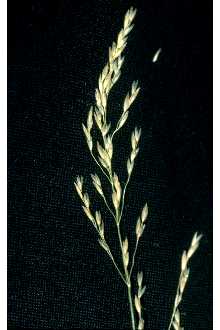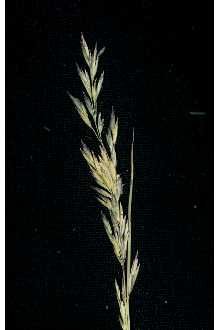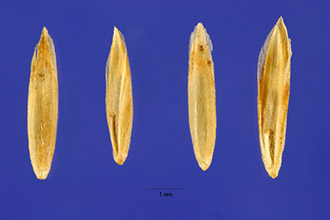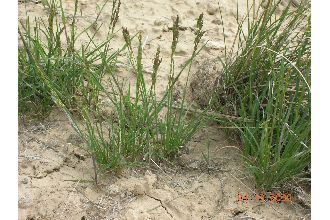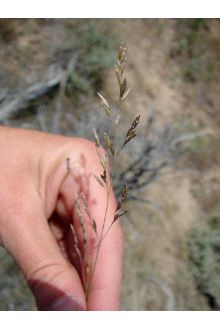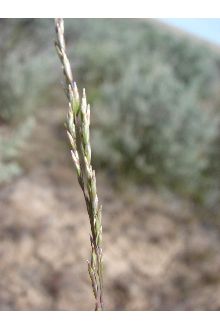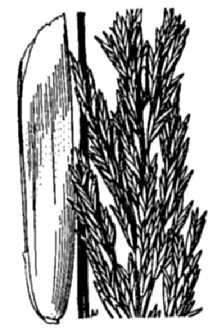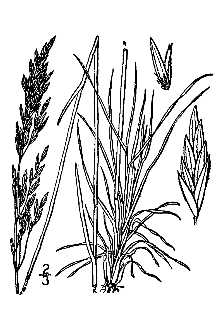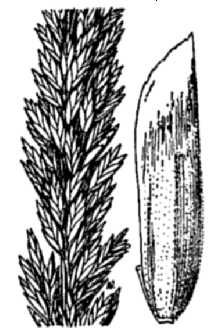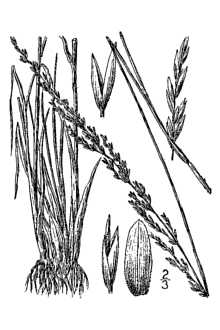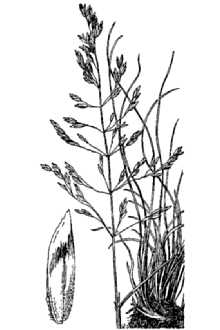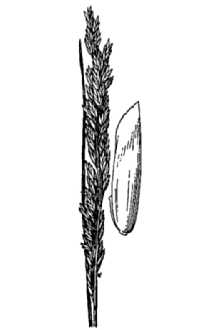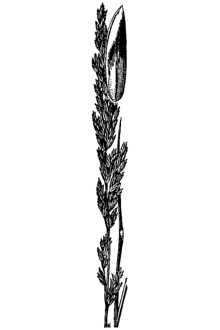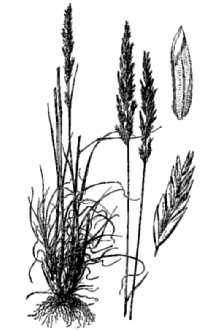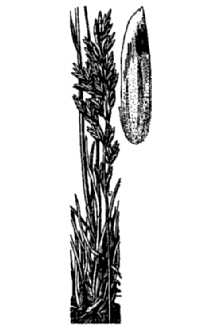Poa juncifolia Scribn.
Scientific Name: Poa juncifolia Scribn.
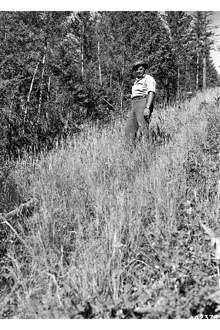
| General Information | |
|---|---|
| Usda Symbol | POJU |
| Group | Monocot |
| Life Cycle | Perennial |
| Growth Habits | Graminoid |
| Native Locations | POJU |
Plant Guide
Alternate Names
P. ampla = Big bluegrass P. canbyi = Canby’s bluegrass P. gracillima = Pacific or Slender bluegrass P. juncifolia = Alkali bluegrass P. nevadensis = Nevada bluegrass P. sandbergii = Sandberg bluegrass P. scabrella = Pine bluegrass
Description
General: The Sandberg bluegrass complex is composed of cool-season (with some summer active ecotypes) perennial bunch grasses. Most accessions mature early in the growing season. This grass is one of the first to green up in the spring, but is commonly cured and dormant by early summer. The plant usually occurs as small tufts, with soft basal leaves and few to many flowering stalks that are naked except for one or two small leaves. The leaves have the typical bluegrass characteristics of prow-shaped tip and double groove down the center of the upper leaf surface. Sandberg bluegrass has a prominent membranaceous, acute ligule. The seeds are glabrous except for short crisp hairs on the lower portion of the lemmas. The flowers are in narrow panicles that are somewhat spreading during anthesis. Plants seldom exceed 60 cm (24 in) in height. Plants of the Sandberg bluegrass complex have extensive, deep penetrating, coarse, fibrous roots that make them quite drought tolerant and resistant to grazing and trampling. Species within the complex have approximately 2,000,000 seeds per kilogram (925,000 seeds per pound). Distribution: Plants occur throughout Western North America with disjunct populations in Quebec and Chile. For current distribution, consult the Plant Profile page for this species on the PLANTS Web site.
Taxonomy
The type specimen for Poa secunda was collected between 1790 and 1794 in “cordilleras Chilensibus” by Thaddeus Haenke and was described by Presl in 1830. In 1892, Sandberg collected a plant near Lewiston, Idaho which was described the following year by Vasey as Poa sandbergii. Presl’s work is recognized as having taxonomic priority due to its earlier date (Arnow 1981). The Sandberg bluegrass complex has included up to 45 named species including eight species recognized by Hitchcock (1935): Canby’s bluegrass (P. canbyi), big bluegrass (P. ampla), little mountain bluegrass (P. curtifolia), Pacific bluegrass (P. gracillima), alkali bluegrass (P. juncifolia), Nevada bluegrass (P. nevadensis), Pine bluegrass (P. scabrella) and the traditional Sandberg bluegrass (P. sandbergii) (Arnow 1981). Kellogg (1985a, 1985b) however, demonstrated that for all species except P. curtifolia, the characters used to separate the species were unreliable. Many were often environmentally determined, for example plants turning red when dry, leaf rolling and leaf glaucusness. Research has shown that under garden and greenhouse conditions these characters don’t exhibit themselves as they do under field conditions (Kellogg 1985b). Other characters vary so widely within a population that they are not reliable to delineate groups within the complex. Based on these findings, Kellogg (1985a) synonomized the entire complex with the exception of P. curtifolia, a well-defined species endemic to serpentine outcrops in the Wenatchee Mountains in Kittitas and Chelan Counties, Washington (Hitchcock and others 1971). Variation in Sandberg bluegrass releases; left to right: ‘Sherman’ big bluegrass, High Plains and Mountain Home Sandberg bluegrass. Derek J. Tilley, USDA NRCS Idaho PMC, Aberdeen, Idaho Although evidence currently points to a large, highly variable suite of forms making up the Sandberg bluegrass complex, the authors of this paper believe that unique phenotypes exist and the separation of these forms is still useful in describing ecological sites, predicting revegetation performance and in making land management decisions. In this light, the authors have decided to provide descriptions here of the seven separate forms of Sandberg bluegrass recognized by Hitchcock (1935), minus P. curtifolia, as an aid to land managers. The following taxonomic key taken from Cronquist and others (1977) should be useful in separating the seven species of the Sandberg bluegrass complex. 1. Lemmas crisp puberulent to nearly glabrous, the pubescence sometimes confined to the very base. 2. Panicles open, the lower branches nearly at right angles to the axis; culms often decumbent at the base; plants summer flowering ……………………………………P. gracillima 2. Panicles contracted or somewhat open; culms usually erect. 3. Plants relatively small, culms mostly less than 30 cm tall; basal leaves forming a short dense tuft, 3-10 cm high; panicles 2-7 cm long; mostly spring flowering...P. sandbergii 3. Plants larger, mostly more than 30 cm tall; basal leaves looser, the tuft 5-30 cm high; panicles 6-16 cm long; mostly summer flowering 4. Basal tuft of leaves 3-15 cm high; panicles 4-12 cm long…........P. scabrella 4. Basal tuft of leaves 15-30 cm high; panicles 9-16 cm long………....P. canbyi 1. Lemmas usually glabrous, sometimes minutely scaberulous 5. Ligules decurrent, long, 1.5-6.5 mm long, acuminate or sharply acute…….P. nevadensis 5. Ligules not obviously decurrent, short, 1-2 mm long, rounded or obtuse to truncate. 6. Blades involute, mostly less than 1.5 mm broad, greenish; plants 20-70 cm tall; usually growing in alkaline soils ...................................................P. juncifolia 6. Blades mostly flat, 1.5-3.5 mm broad, often glaucous; plants robust, 60-180 cm tall; growing in non-alkaline soils……...P. ampla ‘Sherman’ big bluegrass. USDA NRCS. Big bluegrass (Poa ampla) This is the most robust species within the Sandberg bluegrass complex. Culms reach 60 to 130 cm (24 to 48 in) tall, with basal leaves growing to 40 cm (16 in) long and 1.5 to 3.5 mm (1/16 to 1/8 in) wide. The leaves are typically bluish-green and somewhat glaucus. Panicles range from 10 to 18 cm (4 to 7 in) long and are narrow with densely arranged spikelets. This species occupies sagebrush slopes, mid-elevation meadows and openings in aspen stands. Big bluegrass is notable for early green-up, greater forage production and its importance to range management. Canby’s bluegrass (Poa canbyi) Canby’s bluegrass bears green to glaucus leaves with culms to 80 cm (31 in) tall. The basal leaves are typically 15 to 30 cm (6 to 12 in) long and 1 to 3 mm (1/16 to 3/32 in) wide. The panicles are loose to compact with erect branches growing to a length of 16 cm (6 ¼ in). Plants of Canby’s bluegrass grow on open grassy or sagebrush slopes at middle elevations. In its native habitat this species actively grows during the late spring and matures by early July as opposed to P. sandbergii (Cronquist and others 1977) Pacific or Slender bluegrass (Poa gracillima) This is another summer active species. Culms range from 20 to 50 cm (8 to 20 in) tall. Leaf blades are flat and lax from 5 to 15 cm (2 to 5 in) long and 0.7 to 2 mm (1/32 to 1/16 in) wide. The panicles are open and pyramidal. Lemmas of Pacific bluegrass have longer hairs on the keel than P. sandbergii. This species can be found in meadows, stream banks and rocky slopes from British Columbia to the California Sierras, with populations also found in northern Nevada, northern Utah and Colorado. Nevada bluegrass (Poa nevadensis) This is the most robust species within the Sandberg bluegrass complex next to P. ampla. This species is a perennial bunchgrass with culms as much as 100 cm (39 in) tall. Basal leaves typically reach a length of 25 cm (10 in) with a width of 1 to 3 mm (1/16 to 3/32 in). Nevada bluegrass has distinctive long acuminate ligules from 1.5 to as much as 6 mm (1/16 to ¼ in) long. The narrow panicles are 10 to 18 cm (4 to 7 in) long with yellowish-green to purplish-tinged spikelets. Nevada bluegrass can be found in mountain foothill to mountain areas in sagebrush communities including mountain meadows from Alaska to southern California and east to Arizona, Colorado and Montana. Alkali bluegrass (Poa juncifolia) This species is regarded as being closely related to P. ampla (Cronquist and others 1977) and it has been shown that when grown under garden conditions the differences between the two species are lost (Hitchcock and others 1969). Typically the plants are smaller with culms growing 30 to 70 cm (12 to 26 in) tall. Leaf blades are tightly rolled and less than 2 mm (1/16 in) wide. Panicles are narrow, 7 to 15 cm (2 ¾ to 6 in) long with short, ascending branches. This species prefers moist or dry alkaline meadows from the sagebrush zone to mountain communities from British Columbia and south to South Dakota, Wyoming, Nevada, and Utah. Populations have also been found in New Mexico. Sandberg bluegrass (Poa sandbergii) This is probably the most common bluegrass species in the Intermountain West, at least in the drier portions of the region, and is an important species for small animals and birds in spring and fall (Cronquist and others 1977). It is not considered an important forage species for livestock or large wildlife species. Plants are relatively small with culms reaching 20 to 35 cm (8 to 14 in) tall and basal leaves 3 to 5 cm (1 to 2 in) long. Plants occur in dry areas in sagebrush and mountain shrub communities, and occasionally in alpine sites. Pine bluegrass (Poa scabrella) This species can be tentatively separated from Canby’s bluegrass by its being a spring flowering species as opposed to summer, and from Sandberg bluegrass by its smaller size. However; it is admittedly very closely related to both and extremely difficult to separate when the species are found in close proximity to one another. Typically this species is found on relatively dry sites on sagebrush hills and forest lands at low to mid-elevations from British Columbia to Baja California, Nevada Utah and east to Colorado and Minnesota. Pine bluegrass. http://www.tarleton.edu/~range/Home/home.htm
Uses
Sandberg bluegrass species and the other spring ecotypes are palatable to livestock early in the growing season, becoming less desirable during the summer when cured. Summer growing ecotypes are palatable longer into the season. By autumn Sandberg bluegrass is frequently selected again as an available alternative. Deer, pronghorn antelope, and bighorn sheep utilize Sandberg bluegrass forage and birds and small mammals utilize the seed (Johnson and Larson 1999). Because of the small stature and early maturity, most of the species of Sandberg bluegrass do not provide much usable forage; however, big bluegrass and Nevada bluegrass can be important forage producers for larger animals. Sandberg bluegrass is usually a minor component of many grassland communities, but is still considered one of the six most important rangeland grasses of the Intermountain and Pacific Northwest regions (USDA Forest Service 1937). The anticipated use of commercially available Sandberg bluegrass seed is for inclusion in native mixtures for wildlife habitat, reclamation of disturbed sites, restoration of native rangeland and for conservation plantings.
Status
Consult the PLANTS Web site and your State Department of Natural Resources for this plant’s current status (e.g. threatened or endangered species, state noxious status, and wetland indicator values).
Adaptation
Sandberg bluegrass is considered an increaser in mid and short-grass prairies, mountain meadows, and foothills of south-central Canada and western United States (Dakotas west to Washington), south to Mexico (Hitchcock 1935) (Hitchcock & Cronquist 1976), It is found at elevations ranging from 100 to 3,650 meters (300 to 12,000 ft), Use soil moisture sensors to measure the soil moisture of Poa juncifolia Scribn.., It grows well on medium texture soils but is also common on badlands, ridge tops, and dry, stony, or sandy soils, It is a pioneer species, one of the first grasses to colonize on disturbed sites, Plants of the Sandberg bluegrass complex occupy a niche in bunchgrass plant communities, The primary area of use would include the northern Great Plains (Montana, Wyoming, North Dakota, South Dakota, Colorado), the Intermountain West including the Great Basin (Idaho, Nevada, Oregon, Washington, Utah), and the Palouse country (Idaho, Oregon, Washington), Sandberg bluegrass is considered to be a facultative apomyct, reproducing primarily (but not limited to) agamospermy, or asexual seed production (Kellogg 1987), Larson and others (2001) showed that genetic diversity within natural populations of Sandberg bluegrass was much greater than that in the releases Sherman or Canbar, Accordingly, releases, such as Reliable Sandberg bluegrass germplasm, have been developed from multiple plant populations to ensure higher amounts of genetic diversity and greater adaptation (Waldron and others 2006),
Establishment
For best results, seed should be planted into a firm, weed-free seedbed, preferably with a drill that will ensure a uniform seed placement of about 6 mm (1/8 to 1/4 inch). The small seed can be broadcast seeded, harrowed, and packed for good seed-soil contact; however, in dryland situations good precipitation at the time of germination is critical for emergence and establishment. The full seeding rate is 1.7 kg/ha PLS (2.0 lb/ac PLS), but this species would seldom be seeded in a pure stand. This species would normally be included in native seed mixtures at a rate of 0.3 to 0.6 kg/ha PLS (1/4 to 1/2 lb/ac PLS). Seeding in early spring is favored in areas that have early growing season moisture patterns such as the Northern Great Plains, while fall dormant seedings are preferred in winter rainfall areas such as the Columbia Basin and most of the Intermountain West. Sandberg bluegrass is considered a pioneer species and is often one of the first grasses to respond to surface manipulation of deteriorated rangeland. Sandberg bluegrass is a relatively short-lived grass, but often perpetuates itself through prolific seed set and shatter.
Management
Sandberg bluegrass will withstand heavy grazing and trampling, in part, because of its early maturity and apparent dormancy during the summer and fall grazing period. When planted in a native reclamation mix, it will be a minor component of the establishing plant community; therefore management should be based on other key species in the mixture. Any new planting should be deferred from livestock grazing until it is well established which may require 1 to 3 years (Schwendiman 1971).
Pests and Potential Problems
Sandberg bluegrass is susceptible to stem and leaf rusts which can significantly decrease seed production (Mosman 2005). Rust outbreaks can be prevented and controlled by applying a 14 oz rate of systemic fungicides such as Propiconazole and Azoxystrobin (‘Quilt’ tm). Always follow the label in any pesticide application.
Environmental Concerns
Concerns
Concerns
Sandberg bluegrass is a native perennial grass that is considered an increaser under heavy grazing conditions and is a pioneer (early colonizing species) on rangeland disturbances or surface manipulated sites. This species is a bunchgrass and seed shatter does not travel far from the parent plant. It occupies space in bunchgrass plant communities and assists with deterring invasive species encroachment due to its extensive root system. It is recommended in mixtures on sites needing an early spring perennial grass to compete against annual weeds. Sandberg bluegrass is known to fill in interspaces between larger bunchgrasses and effectively impedes the spread of cheatgrass (Monsen and others 2004). Seed may be consumed by songbirds, upland game birds, and small mammals and spread through feces. Sandberg bluegrass is not aggressive, and therefore is not considered to be invasive.
Seed Production
Seed should be planted in rows using a drill that will ensure a uniform 6 mm (1/4 inch) planting depth. Seeding is best in early spring (April 1 to May 15). Seed in rows with at least 45-60 cm (18-24 in) spacing on irrigated sites and 75-90 cm (30-36 in) on dryland sites. Seed production should not be attempted on dryland sites receiving less than 380 mm (15 inches) of annual precipitation. Seed of this species matures early, so a long growing season is not necessary. However, seed production should not be attempted in areas that have a high probability of a killing frost past May 15th. Commercial seed production fields of Sandberg bluegrass will not produce seed the first (establishment) year. Seed production fields should be established using a rate of 150 to 250 seeds/linear meter of row (50-80 PLS/linear foot). This will equate to 0.6 to 1.2 kg/ha (0.5 to 1 lb/ac) of pure live seed. Because of the small seed size, seeding rates are often in the neighborhood of 2.2 kg/ha (2 lb/ac) because of the difficulty in metering such a small volume of seed through a drill. Seeding in wide-spaced rows facilitates weed control and allows for more robust plant development resulting in optimum seed production. Close cultivation should occur only during the establishment year. As the stand matures, cultivation should be further away from the row, allowing tillering from the edges and preventing damage to surface roots. There are several broadleaf herbicides that are registered for use in grass seed production fields, however, options are limited for chemical control of annual grassy weeds. The average harvest date in south-central Montana ranges from June 24 to August 19; the harvest date varying with spring and early summer climatic conditions. Good seed production can be expected during the second and third years of production with seed production dropping off drastically the fourth year. Expected seed production is 85-175 kg/ha (75-150 lbs/ac) on dryland and 110-445 kg/ha (100-400 lbs/ac) on irrigated sites. Seed ripening is uniform enough that seed can be direct combined, but swathing and combining from a cured windrow is the preferred method of harvest. Cultivars, Improved, and Selected Materials (and area of origin) Various "ecotypes" should be utilized within a reasonable geographic range from the original source, since available releases are primarily source identified or selected germplasm releases and have not been progeny tested to determine their range of adaptation and performance. Service big bluegrass (Poa ampla) comes from a collection made east of Whitehorse, Yukon Territory, Canada. It is intended for use in reclamation, native habitat restoration and erosion control throughout most of Alaska (Alderson and Sharp 1994). Breeder seed is available through the Alaska Plant Materials Center, Palmer, Alaska. ‘Sherman’ big bluegrass (Poa ampla) was collected from a native population near Moro, Sherman County, Oregon in 1932 and this cultivar was released in 1945 by the Washington, Idaho and Oregon Agricultural Experiment Stations and the Pullman Washington Plant Materials Center. This is a large stature bunchgrass growing to nearly 1 meter tall (Alderson and Sharp 1994). It is intended for use in range reseeding, cropland retirement plantings, and revegetation of disturbed lands in mountain brush communities and openings in aspen and conifer forests. It is best adapted to areas that receive 10-24 inches of annual precipitation. Plants of Sherman are readily eaten by livestock and large game. Foundation seed is available through Washington State Crop Improvement Association, and breeder seed is maintained by the Pullman, Washington Plant Materials Center. ‘Canbar’ Canby’s bluegrass (Poa canbyi) is a cultivar release and was selected from a single collection made in the Blue Mountains, Columbia County, Washington. It is adapted to sites receiving 10 to 24 inches annual precipitation and is intended for use in basin, Wyoming and mountain big sagebrush plant communities in western states. Canbar should be used in a mixture on sites needing an early spring perennial grass to compete against annual weeds. Canbar is known to fill in interspaces between larger bunchgrasses and effectively impedes the spread of cheatgrass (Monsen and others 2004). Foundation seed is available through the Washington State Crop Improvement Association. Breeder seed is maintained by the Pullman, Washington Plant Materials Center. Opportunity Selected Germplasm Nevada bluegrass (Poa nevadensis) was released in 2008 from the Bridger Plant Materials Center. This is the first release of the Nevada bluegrass type to the commercial seed industry. The Nevada bluegrass type is a more robust, taller, significantly more productive and later maturing grass than the Sandberg bluegrass type. The original collection of this seed came from a site near Wisdom Junction along Highway 1 east of Anaconda, Montana. This site was severely contaminated with heavy metals from smelter fallout and other mine tailing sources. This release is a late maturing, large stature bluegrass with folded leaves similar to big bluegrass and long ligules. It is best adapted to 2000 to 6500 feet (610 to 1980 m), native to drastically disturbed sites in the 10 to 18 inch mean annual precipitation zones. This collection has performed well on sites with low pH and contamination by heavy metals. G1 (equivalent to Foundation) seed is available to commercial growers through the Foundation Seed Program at Montana State University and the University of Wyoming. The Montana and Wyoming Seed Certification Programs will recognize G2 (equivalent to Registered) and G3 (equivalent to Certified) classes of germplasm. Seed production field of High Plains Sandberg bluegrass at the Bridger, MT PMC. Susan Winslow, USDA NRCS Montana PMC, Bridger, Montana High Plains Selected Germplasm Sandberg bluegrass (Poa sandbergii) was released in 2000 from the Bridger Plant Materials Center. This is the first release of the Poa sandbergii type to the commercial seed industry. This release is a composite of three accessions originating from the high plains of Wyoming; one each from Natrona (300-350 mm precip., elev. 1,590 m), Campbell (250-300 mm precip., elev. 1,430 m), and Uinta (175-225 mm precip., elev. 1,920 m) counties. G1 (equivalent to Foundation) seed is available to commercial growers through the Foundation Seed Program at Montana State University and the University of Wyoming. The Montana and Wyoming Seed Certification Programs will recognize G2 (equivalent to Registered) and G3 (equivalent to Certified) classes of germplasm. Mountain Home Germplasm Sandberg bluegrass (Poa sandbergii) is test material from the USDA Forest Service Rocky Mountain Research Station in Boise, ID. Mountain Home Germplasm is not a release at this point, but is under commercial production and being utilized in seed mixes in the Intermountain West. Hanford Source Identified Germplasm Sandberg bluegrass (Poa sandbergii) is a release from L&H Seeds in Connell, Washington. The original material was collected from Hanford, Washington from an area receiving an average 6 inches of annual precipitation. It is adapted to droughty regions in the west and/or locations with well drained sandy soils. Duffy Creek and Wallowa Source Identified Germplasm (Poa sandbergii) are releases from Benson Farms Inc. Both are intended for use in arid sites throughout the western states. Reliable Selected Germplasm Sandberg bluegrass (Poa sandbergii) was released by the USDA-ARS and the Utah Agricultural Experiment Station in 2004. This is a multi-origin germplasm stemming from 28 collections representing seven USDA-NRCS ecological sites. Reliable was developed for its high genetic diversity and to provide adaptation over a broad ecological range (Waldron and others 2006). G1 and G2 seed is maintained by the USDA-ARS Forage and Range Research Laboratory, Logan, UT. G3 seed is available through the Utah Crop Improvement Association. Seed through the G5 generation will be eligible for certification as Selected Class germplasm.
References
Alderson, J. and W.C. Sharp. 1994. Grass Varieties in the United States. Rev. ed. Agricultural Handbook 170. Washington, DC: U.S. Department of Agriculture, Soil Conservation Service. 296 p. Arnow, L.A. 1981. Poa secunda Presl. Versus P. sandbergii Vasey (Poaceae). Systmatic Botany 6:412-421. Cronquist, A., A.H. Holmgren, N.H. Holmgren and J.L. Reveal. 1977. Intermountain Flora: Vascular Plants of the Intermountain West, U.S.A. The New York Botanical Garden. Hitchcock, A.S. 1935. Manual of the Grasses of the United States. Miscellaneous Publication No. 200. US Printing Office, Washington D.C. Hitchcock, C.L., A. Cronquist, M. Owenby and J.W. Thompson. 1969. Vascular Plants of the Pacific Northwest. University of Washington Press. Seattle, WA. Hitchcock, C.L. and A. Cronquist. 1976. Flora of the Pacific Northwest-An Illustrated Manual. University of Washington Press. Seattle, WA. Johnson, R.J. and G.E. Larson. 1999. Grassland Plants of South Dakota and the Northern Great Plains. B-566, South Dakota State University, Brookings, SD. Kellogg, E.A. 1985a. A biosystematic study of the Poa secunda complex. J. Arnold Arboretum 66:201-242. Kellogg, E.A. 1985b. Variation and names in the Poa secunda complex. J. Range Management. 38:516-521. Kellogg, E.A. 1987. Apomixis in the Poa secunda complex. American Journal of Botany 74: 1431-1437. Monsen, S.B., Stevens, R. and N. Shaw. 2004. Grasses. In: S.B. Monsen, R. Stevens, and N.L. Shaw [compilers]. Restoring western ranges and wildlands. Fort Collins, CO: USDA Forest Service, Rocky Mountain Research Station. General Technical Report RMRS-GTR-136-vol-2. p. 295-424. Mosman, D. 2005. Personal communication. Mosman Seed Ranch. Craigmont, ID. Schwendiman, J.L. 1971. Culture and uses of ‘Sherman’ big bluegrass. USDA SCS Plant Science Handbook. Spokane, WA. USDA Forest Service. 1937. Range Plant Handbook. U.S Government Printing Office, Washington D.C. Waldron, B.L., S.R. Larson, K.B. Jensen, R.D. Harrison, A.J. Palazzo and T.J. Cary. 2006. Registration of Reliable Sandberg Bluegrass Germplasm. Crop Science 46: 487-488.
Prepared By
Derek Tilley, USDA NRCS Plant Materials Center, Aberdeen, Idaho Dan Ogle, Plant Materials Specialist, USDA NRCS, Boise, Idaho Mark Majerus, USDA NRCS Plant Materials Center, Bridger, Montana (retired) Roger Hybner, USDA NRCS, Plant Materials Center, Bridger, Montana Larry Holzworth, USDA NRCS, Bozeman, Montana (retired) Mark Stannard, USDA NRCS, Plant Materials Center, Pullman, Washington Species Coordinator Dan Ogle, USDA NRCS, Boise, Idaho Edited: djt010407; dgo041008; lkh110706; ms120706; 081006 jsp For more information about this and other plants, please contact your local NRCS field office or Conservation District, and visit the PLANTS Web site<http://plants.usda.gov> or the Plant Materials Program Web site <http://Plant-Materials.nrcs.usda.gov> The U.S. Department of Agriculture (USDA) prohibits discrimination in all its programs and activities on the basis of race, color, national origin, sex, religion, age, disability, political beliefs, sexual orientation, and marital or family status. (Not all prohibited bases apply to all programs.) Persons with disabilities who require alternative means for communication of program information (Braille, large print, audiotape, etc.) should contact USDA's TARGET Center at 202-720-2600 (voice and TDD). To file a complaint of discrimination write USDA, Director, Office of Civil Rights, Room 326-W, Whitten Building, 14th and Independence Avenue, SW, Washington, DC 20250-9410 or call 202-720-5964 (voice or TDD). USDA is an equal opportunity provider and employer. Read about Civil Rights at the Natural Resources
Fact Sheet
Alternate Names
big bluegrass; Poa ampla, Poa canbyi, Poa confuse, Poa gracillima, Poa sandbergii, Poa scabrella, Poa nevadensis, Poa laevigata, Poa juncifolia, Poa incurve; some of these synonyms, such as Poa nevadensis are sometimes recognized at the species level in some states.
Uses
Livestock: Early spring grazing by cattle or sheep is one of the primary uses of Sandberg bluegrass seedings. In adapted areas, there is no other grass that provides an equal volume of early spring forage. It makes good spring calving or lambing pasture. Wildlife: Upland game birds, especially pheasants, choose fields of Sandberg bluegrass for nesting sites because Sandberg bluegrass has more early spring growth than other dryland grasses and the basal leaves provide good shade. Woodland: Sandberg bluegrass has been successfully used for reseeding burned-over forest lands in pine forests of the West. It has a remarkable ability to produce roots which effectively suppress weed growth. Robert H. Mohlenbrock USDA NRCS 1992 Western Wetland Flora @USDA NRCS PLANTS
Status
Please consult the PLANTS Web site and your State Department of Natural Resources for this plant’s current status (e.g. threatened or endangered species, state noxious status, and wetland indicator values).
Description
Sandberg bluegrass is one of the native bluegrasses and is an important component of the sagebrush grassland vegetation in the western United States. It is a medium-sized cool season bunchgrass with numerous fine basal leaves 8 to 16 inches long. These leaves are a smooth, deep blue green and are folded with keel-shaped tips typical of bluegrasses. This long-lived perennial reaches 2 to 4 feet in height. Its inflorescence is a narrow panicle up to 8 inches long. It has a strong fibrous root system but will occasionally develop short rhizomes. The flower spikelets do not have a web of hairs at the base, unlike Kentucky bluegrass, which does. Sandberg bluegrass begins growth early in spring, before crested wheatgrass, and matures in early summer unless moisture is sufficient to keep it green all summer. In this respect it is the most persistent of all the cool season grasses.
Adaptation and Distribution
Distribution
Distribution
This native bluegrass thrives on a variety of soils from moderately coarse sands to fine clays. It will tolerate coarse sands and dense clays, but will not grow under saline conditions and can tolerate weakly acid or alkaline soils. Well-drained mountain loams are a good place to look for Sandberg bluegrass stands. Although it grows in moist conditions (15 to 20 inch precipitation zone) it will not tolerate early spring flooding, high water tables, or poor drainage. It does best with cool winter moisture above 7,000 feet. It has excellent cold tolerance but does not do as well as other cool season grasses during drought. Its tolerance to shade and grazing is moderate but its ability to withstand burning is very low except when dormant. Sandberg bluegrass is distributed throughout the West. For a current distribution map, please consult the Plant Profile page for this species on the PLANTS Web site.
Establishment
Seed of Sandberg bluegrass should be drilled at 1/4 to 3/4 inches deep depending upon soil type: 1/4 inch for fine, moist soils, 1/2 inch for medium textures, and 3/4 inch for coarse or dry soils, On semiarid lands, 3 pounds pure live seed (PLS) per acre is adequate, Harsh or erosive sites require doubling of the seeding rate as does broadcast seeding, The seed should be planted 2 months prior to the most reliable precipitation: usually early spring, late summer or late fall depending upon the area, When seeding in spring it is advisable to plant as soon as possible since high soil temperatures will put the seedlings into dormancy, Prechilling will improve germination of the seed, Use soil moisture sensors to measure the soil moisture of Poa juncifolia Scribn.., Seedling vigor is moderate to good for a bluegrass, It does not respond significantly to irrigation and gives only moderate response to nitrogen applications, It is weakly compatible to seeding with other cool season species, It can be seeded with other grasses, forbs, legumes, or shrubs, Weed control may be needed,
Management
Sandberg bluegrass has good palatability to livestock in spring and fall and to deer in the spring. It has excellent palatability to elk all year. Cattle prefer Sandberg bluegrass in the spring and it should be grazed when it reaches eight inches in height. Livestock graze Sandberg bluegrass in the vegetative stage, but avoid it when headed. Livestock should be removed while there is still enough moisture in the ground to allow regrowth before plants go dormant. Regrowth can be grazed after the plants turn green in the fall, but a 6-inch stubble should be left. Overgrazing and severe trampling are injurious to native stands of this grass and without proper protective grazing, a range will deteriorate rapidly. New seedlings are easily pulled up by grazing animals and, therefore, should not be grazed until the stands are more than 2 years old and are sufficiently well-rooted to withstand grazing. Spring and fall grazing are recommended. When properly managed, Sandberg bluegrass will compete with cheatgrass.
Plant Traits
Growth Requirements
| Fertility Requirement | Medium |
|---|---|
| Cold Stratification Required | No |
| Cold Stratification Required | No |
| Cold Stratification Required | No |
| Cold Stratification Required | No |
| Cold Stratification Required | No |
| Drought Tolerance | High |
| Drought Tolerance | High |
| Drought Tolerance | High |
| Drought Tolerance | Medium |
| Drought Tolerance | Medium |
| Fertility Requirement | Low |
| Fertility Requirement | Medium |
| CaCO3 Tolerance | Medium |
| Fertility Requirement | Medium |
| Fertility Requirement | Medium |
| Fire Tolerance | High |
| Fire Tolerance | High |
| Fire Tolerance | High |
| Fire Tolerance | Low |
| Fire Tolerance | Medium |
| Frost Free Days, Minimum | 130 |
| Frost Free Days, Minimum | 135 |
| Frost Free Days, Minimum | 135 |
| Frost Free Days, Minimum | 90 |
| Frost Free Days, Minimum | 90 |
| Adapted to Medium Textured Soils | Yes |
| Adapted to Coarse Textured Soils | Yes |
| Adapted to Coarse Textured Soils | Yes |
| Adapted to Coarse Textured Soils | Yes |
| Adapted to Coarse Textured Soils | Yes |
| Adapted to Coarse Textured Soils | Yes |
| Adapted to Fine Textured Soils | No |
| Adapted to Fine Textured Soils | No |
| Adapted to Fine Textured Soils | No |
| Adapted to Fine Textured Soils | No |
| Adapted to Fine Textured Soils | No |
| Adapted to Medium Textured Soils | Yes |
| Adapted to Medium Textured Soils | Yes |
| Temperature, Minimum (°F) | -43 |
| Adapted to Medium Textured Soils | Yes |
| Adapted to Medium Textured Soils | Yes |
| Anaerobic Tolerance | Low |
| Anaerobic Tolerance | Low |
| Anaerobic Tolerance | Low |
| Anaerobic Tolerance | None |
| Anaerobic Tolerance | None |
| CaCO3 Tolerance | High |
| CaCO3 Tolerance | High |
| CaCO3 Tolerance | High |
| CaCO3 Tolerance | Medium |
| Salinity Tolerance | Low |
| Precipitation, Minimum | 10 |
| Precipitation, Minimum | 10 |
| Precipitation, Minimum | 12 |
| Precipitation, Minimum | 14 |
| Precipitation, Minimum | 8 |
| Root Depth, Minimum (inches) | 10 |
| Root Depth, Minimum (inches) | 10 |
| Root Depth, Minimum (inches) | 10 |
| Root Depth, Minimum (inches) | 12 |
| Root Depth, Minimum (inches) | 12 |
| Salinity Tolerance | Low |
| Salinity Tolerance | Low |
| Hedge Tolerance | None |
| Salinity Tolerance | Low |
| Salinity Tolerance | Low |
| Shade Tolerance | Intermediate |
| Shade Tolerance | Intermediate |
| Shade Tolerance | Intermediate |
| Shade Tolerance | Intermediate |
| Shade Tolerance | Intermediate |
| Temperature, Minimum (°F) | -33 |
| Temperature, Minimum (°F) | -33 |
| Temperature, Minimum (°F) | -36 |
| Temperature, Minimum (°F) | -43 |
| Precipitation, Maximum | 22 |
| Hedge Tolerance | None |
| Hedge Tolerance | None |
| Hedge Tolerance | None |
| Hedge Tolerance | None |
| Moisture Use | Low |
| Moisture Use | Low |
| Moisture Use | Medium |
| Moisture Use | Medium |
| Moisture Use | Medium |
| pH, Maximum | 7.8 |
| pH, Maximum | 8.0 |
| pH, Maximum | 8.0 |
| pH, Maximum | 8.0 |
| Precipitation, Maximum | 24 |
| Precipitation, Maximum | 22 |
| Precipitation, Maximum | 22 |
| Precipitation, Maximum | 16 |
| pH, Minimum | 6.5 |
| pH, Minimum | 6.5 |
| pH, Minimum | 6.1 |
| pH, Minimum | 6.0 |
| pH, Minimum | 5.0 |
| pH, Maximum | 8.2 |
Morphology/Physiology
| Resprout Ability | No |
|---|---|
| Resprout Ability | No |
| Resprout Ability | No |
| Resprout Ability | No |
| Shape and Orientation | Erect |
| Shape and Orientation | Erect |
| Shape and Orientation | Erect |
| Shape and Orientation | Erect |
| Shape and Orientation | Semi-Erect |
| Toxicity | None |
| Toxicity | None |
| Toxicity | None |
| Toxicity | None |
| Toxicity | None |
| Active Growth Period | Spring |
| Flower Conspicuous | No |
| Fall Conspicuous | No |
| Fire Resistant | No |
| Fire Resistant | No |
| Fire Resistant | No |
| Fire Resistant | No |
| Fire Resistant | No |
| Flower Color | Yellow |
| Flower Color | Yellow |
| Flower Color | Yellow |
| Flower Color | Yellow |
| Flower Color | Yellow |
| Flower Conspicuous | No |
| Flower Conspicuous | No |
| Flower Conspicuous | No |
| Fall Conspicuous | No |
| Flower Conspicuous | No |
| Foliage Color | Green |
| Foliage Color | Green |
| Foliage Color | Green |
| Foliage Color | Green |
| Foliage Color | Green |
| Foliage Porosity Summer | Dense |
| Foliage Porosity Summer | Moderate |
| Foliage Porosity Summer | Moderate |
| Foliage Porosity Summer | Moderate |
| Foliage Porosity Summer | Porous |
| Foliage Porosity Winter | Porous |
| Foliage Porosity Winter | Porous |
| Bloat | None |
| Resprout Ability | No |
| Active Growth Period | Spring |
| Active Growth Period | Spring |
| Active Growth Period | Spring and Fall |
| Active Growth Period | Spring and Summer |
| After Harvest Regrowth Rate | Moderate |
| After Harvest Regrowth Rate | Moderate |
| After Harvest Regrowth Rate | Slow |
| After Harvest Regrowth Rate | Slow |
| After Harvest Regrowth Rate | Slow |
| Bloat | None |
| Bloat | None |
| Bloat | None |
| Bloat | None |
| Nitrogen Fixation | None |
| C:N Ratio | High |
| C:N Ratio | Medium |
| C:N Ratio | Medium |
| C:N Ratio | Medium |
| C:N Ratio | Medium |
| Coppice Potential | No |
| Coppice Potential | No |
| Coppice Potential | No |
| Coppice Potential | No |
| Coppice Potential | No |
| Fall Conspicuous | No |
| Fall Conspicuous | No |
| Fall Conspicuous | No |
| Lifespan | Long |
| Height, Mature (feet) | 1.4 |
| Height, Mature (feet) | 1.4 |
| Height, Mature (feet) | 1.4 |
| Height, Mature (feet) | 2.3 |
| Known Allelopath | No |
| Known Allelopath | No |
| Known Allelopath | No |
| Known Allelopath | No |
| Known Allelopath | No |
| Leaf Retention | No |
| Leaf Retention | No |
| Leaf Retention | No |
| Leaf Retention | No |
| Leaf Retention | No |
| Foliage Porosity Winter | Porous |
| Lifespan | Long |
| Lifespan | Long |
| Lifespan | Long |
| Lifespan | Moderate |
| Low Growing Grass | No |
| Low Growing Grass | No |
| Low Growing Grass | No |
| Low Growing Grass | Yes |
| Low Growing Grass | Yes |
| Nitrogen Fixation | None |
| Nitrogen Fixation | None |
| Nitrogen Fixation | None |
| Nitrogen Fixation | None |
| Growth Rate | Slow |
| Height, Mature (feet) | 1.3 |
| Foliage Porosity Winter | Porous |
| Foliage Porosity Winter | Porous |
| Foliage Texture | Fine |
| Foliage Texture | Fine |
| Foliage Texture | Fine |
| Foliage Texture | Fine |
| Foliage Texture | Medium |
| Fruit/Seed Color | Brown |
| Fruit/Seed Color | Brown |
| Fruit/Seed Color | Brown |
| Fruit/Seed Color | Brown |
| Fruit/Seed Color | Brown |
| Fruit/Seed Conspicuous | No |
| Fruit/Seed Conspicuous | No |
| Fruit/Seed Conspicuous | No |
| Growth Rate | Rapid |
| Growth Rate | Moderate |
| Growth Rate | Moderate |
| Growth Rate | Moderate |
| Growth Form | Bunch |
| Growth Form | Bunch |
| Growth Form | Bunch |
| Growth Form | Bunch |
| Fruit/Seed Conspicuous | No |
| Fruit/Seed Conspicuous | No |
| Growth Form | Bunch |
Reproduction
| Propagated by Sod | No |
|---|---|
| Propagated by Sprigs | No |
| Propagated by Sprigs | No |
| Propagated by Sprigs | No |
| Propagated by Sprigs | No |
| Propagated by Sprigs | No |
| Propagated by Tubers | No |
| Propagated by Tubers | No |
| Propagated by Tubers | No |
| Propagated by Tubers | No |
| Propagated by Tubers | No |
| Fruit/Seed Persistence | No |
| Propagated by Sod | No |
| Propagated by Sod | No |
| Propagated by Sod | No |
| Propagated by Sod | No |
| Propagated by Seed | Yes |
| Propagated by Seed | Yes |
| Propagated by Seed | Yes |
| Propagated by Seed | Yes |
| Propagated by Seed | Yes |
| Propagated by Cuttings | No |
| Propagated by Cuttings | No |
| Propagated by Cuttings | No |
| Propagated by Cuttings | No |
| Seedling Vigor | Low |
| Vegetative Spread Rate | None |
| Vegetative Spread Rate | None |
| Vegetative Spread Rate | None |
| Vegetative Spread Rate | None |
| Vegetative Spread Rate | None |
| Small Grain | No |
| Small Grain | No |
| Small Grain | No |
| Small Grain | No |
| Small Grain | No |
| Seedling Vigor | Medium |
| Seedling Vigor | Low |
| Seed per Pound | 1046960 |
| Seedling Vigor | Low |
| Seedling Vigor | Low |
| Seed Spread Rate | Slow |
| Seed Spread Rate | Slow |
| Seed Spread Rate | Slow |
| Seed Spread Rate | Slow |
| Seed Spread Rate | Moderate |
| Seed per Pound | 1046960 |
| Seed per Pound | 1046960 |
| Seed per Pound | 1046960 |
| Seed per Pound | 1046960 |
| Fruit/Seed Abundance | Low |
| Fruit/Seed Period End | Summer |
| Fruit/Seed Period End | Summer |
| Fruit/Seed Period End | Summer |
| Fruit/Seed Period End | Summer |
| Fruit/Seed Period Begin | Summer |
| Fruit/Seed Period Begin | Summer |
| Fruit/Seed Period Begin | Spring |
| Fruit/Seed Period Begin | Spring |
| Fruit/Seed Period Begin | Spring |
| Fruit/Seed Abundance | Medium |
| Fruit/Seed Abundance | Low |
| Fruit/Seed Abundance | Low |
| Propagated by Corm | No |
| Fruit/Seed Abundance | Low |
| Commercial Availability | Routinely Available |
| Commercial Availability | Routinely Available |
| Commercial Availability | Routinely Available |
| Commercial Availability | Routinely Available |
| Commercial Availability | Routinely Available |
| Bloom Period | Mid Spring |
| Bloom Period | Mid Spring |
| Bloom Period | Late Spring |
| Bloom Period | Late Spring |
| Bloom Period | Late Spring |
| Propagated by Cuttings | No |
| Fruit/Seed Persistence | No |
| Fruit/Seed Period End | Summer |
| Propagated by Corm | No |
| Propagated by Corm | No |
| Propagated by Corm | No |
| Propagated by Corm | No |
| Propagated by Container | No |
| Propagated by Container | No |
| Propagated by Container | No |
| Propagated by Container | No |
| Propagated by Container | No |
| Propagated by Bulb | No |
| Propagated by Bulb | No |
| Propagated by Bulb | No |
| Propagated by Bulb | No |
| Fruit/Seed Persistence | No |
| Fruit/Seed Persistence | No |
| Fruit/Seed Persistence | No |
| Propagated by Bare Root | No |
| Propagated by Bare Root | No |
| Propagated by Bare Root | No |
| Propagated by Bare Root | No |
| Propagated by Bare Root | No |
| Propagated by Bulb | No |
Suitability/Use
| Post Product | No |
|---|---|
| Post Product | No |
| Post Product | No |
| Post Product | No |
| Palatable Human | No |
| Palatable Human | No |
| Palatable Human | No |
| Palatable Human | No |
| Palatable Human | No |
| Palatable Graze Animal | Medium |
| Palatable Graze Animal | Low |
| Palatable Graze Animal | High |
| Palatable Graze Animal | High |
| Palatable Graze Animal | High |
| Palatable Browse Animal | Medium |
| Palatable Browse Animal | Medium |
| Post Product | No |
| Protein Potential | Low |
| Protein Potential | Medium |
| Protein Potential | Medium |
| Protein Potential | Medium |
| Protein Potential | Medium |
| Pulpwood Product | No |
| Pulpwood Product | No |
| Pulpwood Product | No |
| Pulpwood Product | No |
| Pulpwood Product | No |
| Veneer Product | No |
| Veneer Product | No |
| Veneer Product | No |
| Veneer Product | No |
| Veneer Product | No |
| Christmas Tree Product | No |
| Lumber Product | No |
| Fodder Product | Yes |
| Fodder Product | Yes |
| Fodder Product | Yes |
| Fodder Product | Yes |
| Fodder Product | Yes |
| Christmas Tree Product | No |
| Christmas Tree Product | No |
| Lumber Product | No |
| Christmas Tree Product | No |
| Christmas Tree Product | No |
| Berry/Nut/Seed Product | No |
| Berry/Nut/Seed Product | No |
| Berry/Nut/Seed Product | No |
| Berry/Nut/Seed Product | No |
| Berry/Nut/Seed Product | No |
| Palatable Browse Animal | High |
| Lumber Product | No |
| Lumber Product | No |
| Lumber Product | No |
| Naval Store Product | No |
| Naval Store Product | No |
| Naval Store Product | No |
| Naval Store Product | No |
| Naval Store Product | No |
| Nursery Stock Product | No |
| Nursery Stock Product | No |
| Nursery Stock Product | No |
| Nursery Stock Product | No |
| Nursery Stock Product | No |
| Palatable Browse Animal | High |
| Palatable Browse Animal | High |

